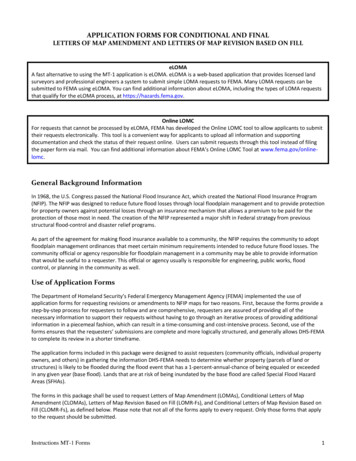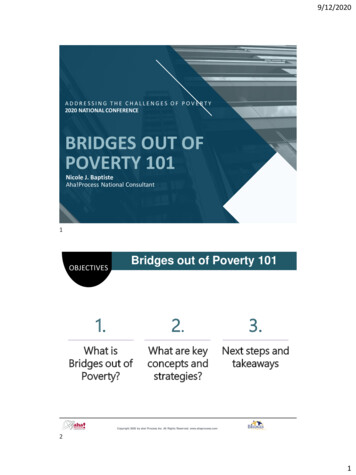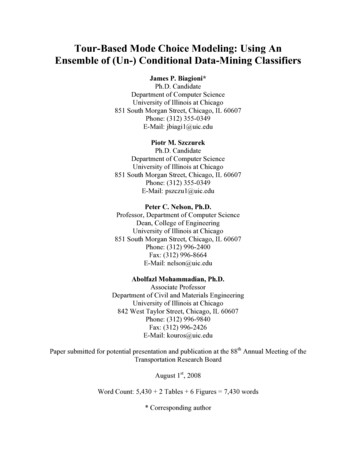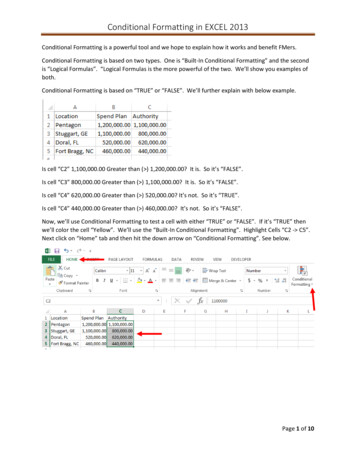
Transcription
APPLICATION FORMS FOR CONDITIONAL AND FINALLETTERS OF MAP AMENDMENT AND LETTERS OF MAP REVISION BASED ON FILLeLOMAA fast alternative to using the MT‐1 application is eLOMA. eLOMA is a web‐based application that provides licensed landsurveyors and professional engineers a system to submit simple LOMA requests to FEMA. Many LOMA requests can besubmitted to FEMA using eLOMA. You can find additional information about eLOMA, including the types of LOMA requeststhat qualify for the eLOMA process, at https://hazards.fema.gov.Online LOMCFor requests that cannot be processed by eLOMA, FEMA has developed the Online LOMC tool to allow applicants to submittheir requests electronically. This tool is a convenient way for applicants to upload all information and supportingdocumentation and check the status of their request online. Users can submit requests through this tool instead of filingthe paper form via mail. You can find additional information about FEMA’s Online LOMC Tool at www.fema.gov/online‐lomc.General Background InformationIn 1968, the U.S. Congress passed the National Flood Insurance Act, which created the National Flood Insurance Program(NFIP). The NFIP was designed to reduce future flood losses through local floodplain management and to provide protectionfor property owners against potential losses through an insurance mechanism that allows a premium to be paid for theprotection of those most in need. The creation of the NFIP represented a major shift in Federal strategy from previousstructural flood‐control and disaster relief programs.As part of the agreement for making flood insurance available to a community, the NFIP requires the community to adoptfloodplain management ordinances that meet certain minimum requirements intended to reduce future flood losses. Thecommunity official or agency responsible for floodplain management in a community may be able to provide informationthat would be useful to a requester. This official or agency usually is responsible for engineering, public works, floodcontrol, or planning in the community as well.Use of Application FormsThe Department of Homeland Security’s Federal Emergency Management Agency (FEMA) implemented the use ofapplication forms for requesting revisions or amendments to NFIP maps for two reasons. First, because the forms provide astep‐by‐step process for requesters to follow and are comprehensive, requesters are assured of providing all of thenecessary information to support their requests without having to go through an iterative process of providing additionalinformation in a piecemeal fashion, which can result in a time‐consuming and cost‐intensive process. Second, use of theforms ensures that the requesters’ submissions are complete and more logically structured, and generally allows DHS‐FEMAto complete its review in a shorter timeframe.The application forms included in this package were designed to assist requesters (community officials, individual propertyowners, and others) in gathering the information DHS‐FEMA needs to determine whether property (parcels of land orstructures) is likely to be flooded during the flood event that has a 1‐percent‐annual‐chance of being equaled or exceededin any given year (base flood). Lands that are at risk of being inundated by the base flood are called Special Flood HazardAreas (SFHAs).The forms in this package shall be used to request Letters of Map Amendment (LOMAs), Conditional Letters of MapAmendment (CLOMAs), Letters of Map Revision Based on Fill (LOMR‐Fs), and Conditional Letters of Map Revision Based onFill (CLOMR‐Fs), as defined below. Please note that not all of the forms apply to every request. Only those forms that applyto the request should be submitted.Instructions MT-1 Forms1
LOMAA letter from DHS‐FEMA stating that an existing structure or parcel of land that has not beenelevated by fill (natural grade) would not be inundated by the base flood.CLOMAA letter from DHS‐FEMA stating that a proposed structure that is not to be elevated by fill (naturalgrade) would not be inundated by the base flood if built as proposed.LOMR‐FA letter from DHS‐FEMA stating that an existing structure or parcel of land that has been elevatedby fill would not be inundated by the base flood.CLOMR‐FA letter from DHS‐FEMA stating that a parcel of land or proposed structure that will be elevated byfill would not be inundated by the base flood if fill is placed on the parcel as proposed or thestructure is built as proposed.If the request is being made for a LOMA to be issued on a single residential property, the MT‐EZ form, entitled “ApplicationForm for Single Lot or Structure, Amendments to National Flood Insurance Program Maps,” may be used instead of theforms in this package. Forms for this purpose may be downloaded from our website at . This form is available in both an English and Spanish version.The forms in this package and the form entitled "Application Form for Single Lot or Structure, Amendments to NationalFlood Insurance Program Maps," shall not be used in the following instances: Requests involving changes in Base Flood Elevations (BFEs); Requests involving changes in regulatory floodway boundary delineations; Requests for properties in alluvial fan areas; Requests involving property and/or structures that have been elevated by fill placed within the regulatoryfloodway, channelization projects, bridge/culvert replacement projects, or other flood control improvements; or Requests involving changes in coastal high hazard areas (V zones).For such requests, the community must submit the request to DHS‐FEMA in accordance with Title 44, Chapter I, Code ofFederal Regulations (CFR), Part 65 of the NFIP regulations, which is available online athttp://www.access.gpo.gov/nara/cfr/waisidx 02/44cfrv1 02.html, using the separately published MT‐2 application formspackage entitled "Application Forms and Instructions for Conditional Letters of Map Revision and Letters of Map Revision."Forms for this purpose may be downloaded from our website at ��and‐instructions.Please note that the forms in this package may be used for property that has been inadvertently included in a V zone or theregulatory floodway. However, if the property is to be removed from a V zone, it must not be located seaward of thelandward toe of the primary frontal dune.For additional assistance in completing these forms, you may consult the LOMA Tutorial, available on DHS‐FEMA’s Internetsite at: ial‐series‐choose‐tutorial.Data Submission RequirementsIn accordance with the NFIP regulations, DHS‐FEMA will use the information provided by these application forms to make adetermination on whether a property (parcel(s) of land or a structure(s)) is located within a designated SFHA. In certaininstances, additional data that are not referenced on these forms may be required. A DHS‐FEMA representative will notifythe requester of any additional requirements.DHS‐FEMA encourages the submission of the required data in digital format (e.g. scanned documents on a CD). This mayhelp expedite the processing of your request.Instructions MT-1 Forms2
Applicable RegulationsThe regulations pertaining to LOMAs, CLOMAs, LOMR‐Fs, and CLOMR‐Fs are presented in Title 44, Chapter I, CFR, Parts 65and 70, which is available online at http://www.access.gpo.gov/nara/cfr/waisidx 02/44cfrv1 02.html. The purpose ofPart 70 is to provide an administrative procedure whereby DHS‐FEMA will review information submitted by an owner orlessee of property who believes that their property has been inadvertently included in a designated SFHA. Part 70 providesinformation about the technical difficulty of accurately delineating the SFHA boundaries on a NFIP map for a community.Part 70 procedures shall not apply if the topography has been altered to raise the original ground to or above the BFE sincethe effective date of the first NFIP map [i.e., a Flood Insurance Rate Map (FIRM) or Flood Hazard Boundary Map] showingthe property to be within the SFHA. Requests involving changes in topography (such as the placement of fill) are handledunder the procedures described in Part 65.Fee RequirementsTitle 44, Chapter I, CFR, Part 72 of the NFIP regulations, which is available online athttp://www.access.gpo.gov/nara/cfr/waisidx 02/44cfrv1 02.html, presents information regarding the fee collectionprocedure initiated by DHS‐FEMA to allow for the recovery of costs associated with the review of requests for CLOMAs,CLOMR‐Fs, and LOMR‐Fs via a review and processing fee. There is no review and processing fee for requests forsingle/multiple, lot/structure LOMAs.Revised fee schedules are published periodically, but no more than once annually, as a notice in the Federal Register. Forthe most up‐to‐date fee schedule, please contact the DHS‐FEMA Map Information eXchange (FMIX) toll free at 1‐877‐FEMAMAP (1‐877‐336‐2627) or consult the DHS‐FEMA Internet site at Payment must be submitted in the form of a check or money order, made payable in U.S. funds to the National FloodInsurance Program, or by credit card payment. In addition, the requester must complete the Payment Information Form.The payment should be mailed together with the application and supporting data to the address listed in the Address forSubmitting Requests section of these instructions.Basis of DeterminationIf no fill has been placed, DHS‐FEMA's determination as to whether the SFHA designation may be removed from thestructure(s) on a property will be based on a comparison of the BFE with the elevation of the Lowest Adjacent Grade to thestructure (lowest ground touching the structure) including any attached decks or garage. If fill has been placed, DHS‐FEMA'sdetermination will be based on a comparison of the BFE with the elevation of the lowest adjacent grade to the structure(lowest ground touching the structure) including any attached decks or garage and a completed CommunityAcknowledgment Form (see instructions for the Community Acknowledgment Form [Form 3] for more information).For DHS‐FEMA to remove the SFHA designation from a legally defined property or portion of property that does not have astructure on it, the elevation of the lowest ground on the property must be at or above the BFE.Please note the following special considerations that may affect DHS‐FEMA's determination: In areas of shallow/sheet flooding (Zone AO), the elevation of the Lowest Adjacent Grade (including deck posts) of thestructure(s) must be above the surrounding grade by an amount equal to or greater than the depth shown on theNFIP map. In addition, adequate drainage paths are required to guide floodwaters around and away from thestructure(s); the structure(s) should be on an elevated pad within the Zone AO area. With your application package, inaddition to elevation information regarding the structure(s), provide a map showing the topographic data of theproperty and the immediate surrounding area, and the location of any structure(s) existing on the property (certifiedby a registered professional engineer or licensed land surveyor) to demonstrate that the above criteria have beenmet. If the lowest floor of a building has been elevated on posts, piers, or pilings above the BFE and any portion of thestructure (i.e., posts, pilings, or piers) is still below the BFE, the building will not be removed from the SFHA.Instructions MT-1 Forms3
Response TimeframeIn accordance with the procedures of Title 44, Chapter I, CFR, Part 72, which is available online athttp://www.access.gpo.gov/nara/cfr/waisidx 02/44cfrv1 02.html, DHS‐FEMA will notify the requester of thedetermination in writing within 60 days of the date of receipt of all required data. Information about the status of activeLetter of Map Change (LOMC) requests is available from DHS‐FEMA’s Mapping Information Platform (MIP) athttps://hazards.fema.gov. The MIP allows requesters to search Open LOMCs by entering their Project (Case) Number andProject Type to find out the status of their request. From the MIP Home Page requesters should click on Tools & Links,Public Reports and select Public Reports from the Report Category dropdown.Effect on Insurance Purchase RequirementsAlthough DHS‐FEMA may issue a LOMA or LOMR‐F removing a structure(s) from the SFHA, it is the lending institution'sprerogative to require flood insurance, as a condition of a loan, if it deems such action appropriate. Historically, about 25%of all flood claims occur in areas outside of the SFHA. Property owners are strongly encouraged to convert their existingpolicy, using the premiums already paid for that policy, to a lower‐cost Preferred Risk Policy (PRP), which is available forstructures located outside the SFHA. For more information about the PRP, contact your agent or broker or visithttp://floodsmart.gov/prp.If the lending institution agrees to waive the flood insurance purchase requirement for a structure, the property owner iseligible for a full refund of the premium paid for the current policy year, provided that no claim is pending or has been paidon the policy in question during the same policy year. If the property owner has been required to renew his or her policyduring a period when a revised NFIP map was being printed, the premium will be refunded for an additional year. To initiateprocessing of the refund, the property owner should provide the LOMA or LOMR‐F and evidence of the waiver of the floodinsurance requirement from the lending institution to the insurance agent or broker who sold the policy.Conditional DeterminationsTo qualify for a CLOMA or CLOMR‐F, the proposed project must meet the same criteria as those required for a LOMA orLOMR‐F. After construction is completed or fill is placed, certified as‐built information must be submitted to DHS‐FEMA fora LOMA or LOMR‐F to be issued. The NFIP regulations do not require that a CLOMA or CLOMR‐F be requested and issuedfor a proposed project. Check with local community officials to see if they are required.Property owners and developers should note that a CLOMA or CLOMR‐F does not remove the mandatory purchase of floodinsurance requirements, it merely provides comment on the proposed plan and does not revise or amend the NFIP map.Once the project has been completed another application will have to be submitted with the as built conditions to receive aLOMA or a LOMR‐F which in turn removes the federal requirements for mandatory purchase of flood insurance. It also doesnot relieve Federal agencies of the need to comply in carrying out their responsibilities for providing federally undertaken,financed, or assisted construction and improvements or in their regulating and licensing activities, in accordance with theprovisions of Executive Order 11988 ed Species Act ComplianceCLOMR‐F applicants are responsible for documenting to FEMA that Endangered Species Act (ESA) compliance has beenachieved prior to FEMA’s review of a CLOMR‐F application. ESA compliance may be documented by submitting to FEMA acopy of an Incidental Take Permit, an Incidental Take Statement, a “not likely to adversely affect” determination from theNational Marine Fisheries Service (NMFS) or the U.S. Fish and Wildlife Service (USFWS), or an official letter from NMFS orUSFWS concurring that the project has “No Effect” on proposed or listed species or designated critical habitat. Theapplicant may begin by contacting a NMFS or USFWS office, State wildlife agency office, or independent biologist to identifywhether threatened or endangered species exist on the subject property and whether the project associated with theCLOMR‐F request would adversely affect species or designated critical habitat. These entities are also available to discussquestions pertaining to listed species and ESA compliance. If potential adverse impacts could occur, then NMFS or USFWSmay require changes to the proposed activity and/or mitigation.Instructions MT-1 Forms4
For CLOMA, LOMA, and LOMR‐F requests involving floodplain activities that have occurred already, privateindividuals and local and state jurisdictions are required to comply with the ESA independently of FEMA’s process.These requests do not provide the same opportunity as CLOMR‐Fs for FEMA to comment on the project becauseCLOMAs and LOMAs do not involve a physical modification to the floodplain and because LOMR‐Fs are issued onlyafter the physical action has been undertaken in the floodplain.Additional information about the ESA and these requirements is available on ��program‐endangered‐species‐act or by requesting a copy from the DHS‐FEMA Map InformationeXchange (FMIX) toll free at 1‐877‐FEMA MAP (1‐877‐336‐2627). Although FEMA’s staff is not available to assistwith this process, NMFS and the USFWS both have staff available around the country to answer questions aboutthreatened and endangered species and ESA compliance.Address for Submitting RequestsDHS‐FEMA encourages electronic submissions through the Online LOMC tool at https://hazards.fema.gov. This toolis a convenient way for applicants to upload all required information and supporting documentation and check thestatus of their request online. Users can submit requests through this tool instead of filing the paper form via mail.However, for requests submitted via mail, DHS‐FEMA encourages the submission of all required data in digitalformat (e.g. scanned documents on a CD). Please submit all application forms and data to support a request for aflood zone determination, including any applicable fees to the address listed below. Incomplete submissions willresult in processing delays.LOMC CLEARINGHOUSE3601 EISENHOWER AVENUE, SUITE 500ALEXANDRIA, VA 22304‐6426FEMA REGIONSInstructions MT-1 Forms4
INSTRUCTIONS FOR COMPLETING THE PROPERTY INFORMATION FORM (FORM 1)General InstructionsThe Property Information Form (Form 1) may be completed by the property owner, or on behalf of the propertyowner by authorized persons including but not limited to; the property owner's agent, licensed land surveyor, orregistered professional engineer to support a request for a Letter of Map Amendment (LOMA), Conditional Letterof Map Amendment (CLOMA), Letter of Map Revision Based on Fill (LOMR‐F), or Conditional Letter of MapRevision Based on Fill (CLOMR‐F) for existing or proposed, single or multiple lots/structures.Before completing this form, the requester must obtain the following documents from the County/Parish Clerk,Recorder, or Register of Deeds for the community: A copy of the Deed for the property, showing the recordation information (e.g., Book/Volume and Pagenumbers or Document/Instrument number) containing the recorder's seal and recordation date,accompanied by a tax assessor's or other suitable map showing the surveyed location of the property.ORA copy of the Plat Map for the property, showing the recordation information (e.g., Book/Volume and Pagenumbers or Document/Instrument number) and containing the recorder's seal and recordation date.The requester also must obtain a photocopy of the effective FIRM panel (including the Title Block) that shows thearea in which the property is located. The FIRM should be available at the community map repository or from thecommunity official or agency responsible for floodplain management. However, digital copies of the FIRM Index andFIRM panels may be available on the Map Service Center (MSC). Interested parties may visit the MSC website athttps://msc.fema.gov/portal or contact the DHS‐FEMA Map Information eXchange by calling 1‐877‐FEMA MAP (1‐877‐336‐2627). A FIRMette, which can also be printed free of charge from the MSC website, may be submitted inlieu of a photocopy of the FIRM. Requesters without Internet access should contact the DHS‐FEMA Map InformationeXchange by calling 1‐877‐FEMA MAP (1‐877‐336‐2627).Requesters should note that for multiple property (structure or lot) requests, this form should only be completedonce to describe the entire project. One form for each lot is not necessary.Specific InstructionsBasis of RequestSelect the type of MT‐1 Letter of Map Change (LOMC) being requested, by checking only one box. Next to each typeof LOMC a brief definition has been provided to assist the requester in making an informed selection.Fill PlacementFill is defined as material from any source (including the subject property) placed that raises the ground (naturalgrade) to or above the Base (1%‐annual‐chance) Flood Elevation (BFE). The common construction practice ofremoving unsuitable existing material (topsoil) and backfilling with select structural material is not considered theplacement of fill if the practice does not alter the existing (natural grade) elevation, which is at or above the BFE.Fill that is placed before the date of the first National Flood Insurance Program (NFIP) map showing the area in aSpecial Flood Hazard Area is considered natural grade. The Special Flood Hazard Area (SFHA) is the area thatwould be inundated by the base flood. Assistance to ascertain if fill has been placed on your property may beavailable from the community official or agency responsible for floodplain management. You may consult with thecommunity map repository to obtain previous editions of the NFIP map, archived topographic data, orpermit drawings related to construction on the site. If the structure footprint is located on ground higher than thesurrounding area, fill may have been placed. Additional sources for assistance would include the developer orengineer/designer of the subdivision, previous owners of the site, persons who have owned or resided on adjacentparcels, and large scale aerial photographs (check the tax assessor’s office). In addition, digital copies of historicNFIP maps may be available on DHS‐FEMA’s Map Service Center (MSC). Interested parties may visit the MSCwebsite at https://msc.fema.gov/portal or contact the DHS‐FEMA Map Information eXchange by calling 1‐877‐Instructions MT-1 Forms5
FEMA MAP (1‐877‐336‐2627). Requesters without Internet access should contact the DHS‐FEMA Map InformationeXchange by calling 1‐877‐FEMA MAP (1‐877‐336‐2627).Regardless of the type of LOMC being requested, DHS‐FEMA must require the requester to clearly state, to thebest of his or her knowledge, whether fill was or was not placed on his or her property. The requester must selecteither “yes” or “no.” If fill was placed on the property, the requester must provide the month and year fill wasplaced.In addition, for proposed projects, DHS‐FEMA requires the requester to clearly state whether fill will be placed onhis or her property. If fill will be placed, the requester must provide the month and year fill will be placed. Inaddition, the applicant must then provide documentation to show that ESA compliance has been achieved.Additional information about these requirements is available on Page 4 of this instruction packet.Number 1 ‐ Street AddressEnter the street address (911 type) for the structure or property being reviewed (subject property). For requestsinvolving multiple lots, structures, or units, attach a separate piece of paper including all street addresses whenspace is insufficient.Number 2 ‐ Legal DescriptionDescribe the property by referring to the Deed or Plat Map. The description may consist of a lot number andsubdivision name, a parcel number, a tract number, or any other information provided in the Deed or Plat toidentify the property (e.g. Lot 2, Block 1, Floodville Estates). It is not necessary to reproduce a lengthy descriptionof the property as it appears in the Deed.Number 3 ‐ Subject of DeterminationDHS‐FEMA makes determinations on parcels of land or structures. The requester should select structure, portionof a parcel, or a parcel of land. If the request is for a structure on a property, the date of construction must beprovided in this section. Date of construction information may usually be obtained from real estate settlementdocuments, the property developer, or the local government office where real estate and/or land developmenttransactions are recorded. If there is more than one structure on a property, attach a separate piece of paper withthe dates of construction. If the request is for a portion of a parcel, a certified metes and bounds description andmap of the area to be removed, certified by a licensed land surveyor or registered professional engineer, arerequired. The metes and bounds description must cover the specific area to be removed, and it must be tied to anidentifiable starting point. If the description is for a legally recorded lot or parcel, the metes and boundsdescription should commence or begin at the lot or parcel corner. Metes and bounds descriptions must notintersect or coincide with the footprint of an existing structure. Please see the example below for the preferredformat of metes and bounds descriptions.BEGINNING at the northeast lot corner; thence S16 42’22”E, 100.00 feet; thence S33 14’40”W,145.92 feet; thence S89 13’29”W, 156.01 feet; thence N16 42’22”W, 223.14 feet; thence 210.49feet along a curve to the left having a radius of 542.00 feet to the POINT OF BEGINNINGDHS ‐ FEMA encourages the submission of metes and bounds descriptions in digital format on CD. Thismay help expedite the processing of your request.Number 4 ‐ Number of Structures or PropertiesDHS‐FEMA makes determinations on single or multiple, lots (parcels of land) or structures. Select the choice thatbest describes your request.Instructions MT-1 Forms6
Required DataAll requests must include the following data: Property description documentation must be enclosed for every request and will consist of either the PlatMap or Deed (containing the recorder's stamp and recordation date) accompanied by a tax assessor's map orother suitable map showing the surveyed location of the property. The recordation data (e.g., Book, Volume,Page, Reel, Document Number, and Date) must be evident on the copies of these documents so that DHS‐FEMA may use the legal description of the property. In addition, DHS‐FEMA must be able to identify theproperty exactly. If the property is not recorded on a Plat Map, a copy of a tax assessor's map or other suitablemap must be submitted to aid DHS‐FEMA in locating the property. The map should include at least one streetintersection that is shown on the FIRM panel. A photocopy of the effective FIRM panel, annotated to show where the property is located, must besubmitted for every request. If your community has a separate Flood Boundary and Floodway Map (FBFM),please include a copy. The panel number and effective date of the FIRM must appear on the copy submitted.The actual map or a photographic copy must be used. The Elevation Form (Form 2) must be included for all requests, except requests for determinations in whichthe FIRM already shows the property to be CLEARLY outside the SFHA. For cases in which the determinationfor the property or structure is uncertain, elevation data must be submitted to provide a definitive determina‐tion. This form must be completed by a licensed land surveyor or registered professional engineer. If an NFIPElevation Certificate has been completed for a structure, it may be submitted in lieu of this form. TheElevation Certificate must be certified by a licensed land surveyor or registered professional engineer. The Community Acknowledgment Form (Form 3) must be included for all LOMR‐F or CLOMR‐F, or for LOMArequests in which the property has been inadvertently included within the NFIP regulatory floodway. ForLOMR‐F and CLOMR‐F requests only Section A needs to be completed. For LOMA requests in which theproperty has been inadvertently included within the regulatory floodway, only Section B needs to becompleted (see INSTRUCTIONS FOR COMPLETING OPTIONAL FORMS of these instructions for additionalinformation on the certification requirements of this form). Documented ESA compliance must be submitted for CLOMR‐Fs only. Appropriate documentation includes acopy of an Incidental Take Permit, an Incidental Take Statement, a “not likely to adversely affect”determination from NMFS or USFWS, or an official letter from NMFS or USFWS concurring that the project has“No Effect” on proposed or listed species or designated critical habitat. Additional information about theserequirements is available on Page 4 of this instruction packet.Review and Processing FeeThe appropriate review and processing fee must be submitted for requests involving proposed projects and forrequests involving the placement of fill (e.g., CLOMA, LOMR‐F, or CLOMR‐F). The Payment Information Formshould be included with the processing fee. No fee is required to obtain a determination based on existingconditions (i.e. LOMA) as long as no fill has been placed. For the current fee schedule visits DHS‐FEMA’s FloodMap‐Related Fees Internet site: SignatureThe requester must provide his or her name, mailing address, and telephone number. The requester must also signand date, where indicated, to certify the accuracy of the information provided. A Licensed Land Surveyor,Registered Professional Engineer, or other designated agent may sign this form for the requester if they aresubmitting on their behalf. Providing an email address is optional, however, providing one will make it easier forDHS‐FEMA to contact you if necessary and may facilitate the processing of your request.Instructions MT-1 Forms7
INSTRUCTIONS FOR COMPLETING THE ELEVATION FORM (FORM 2)General InstructionsThe Elevation Form (Form 2) must be completed by a licensed land surveyor or registered professional engineer(author
In 1968, the U.S. Congress passed the National Flood Insurance Act, which created the National Flood Insurance Program . If the request is being made for a LOMA to be issued on a single residential property, the MT‐EZ form, entitled "Application Form for Single Lot or Structure, Amendments to National Flood Insurance Program Maps," may .











